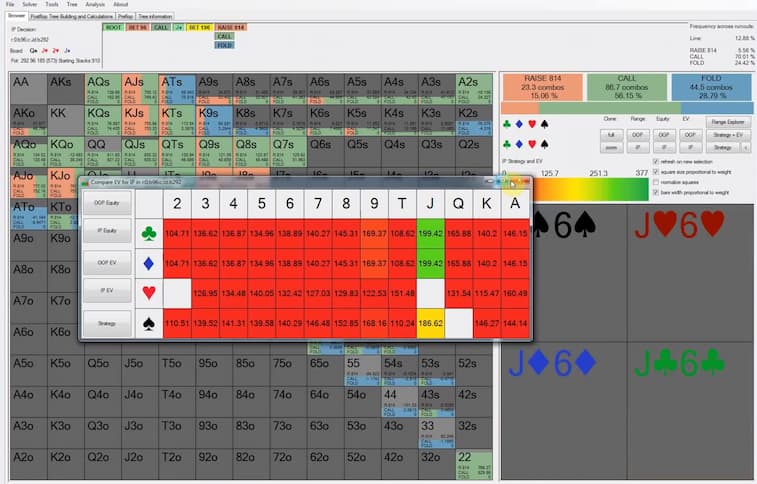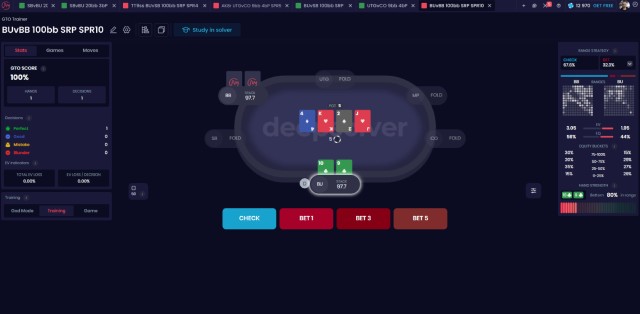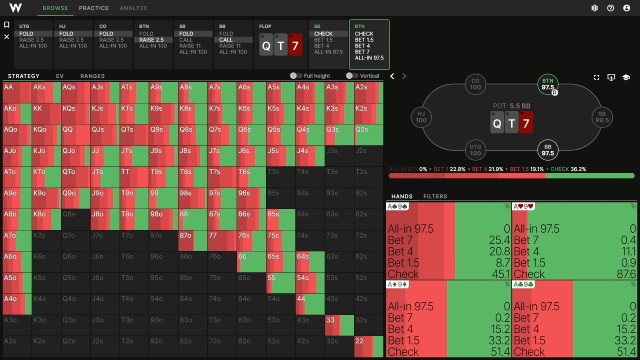Right now, poker, especially in an online environment, is a heavily studied and developed game. There is an abundance of poker tools and software available on the web. In the last few years, Texas Holdem has become a mainstream game, and due to its popularity, players can access a lot of valuable coaching materials for free.
As you may have already read on our blog, the incorporation of game theory into poker strategy has changed the understanding and development of the game forever. That change is so big that nowadays, it’s almost impossible to become an excellent poker player without understanding the basics of game theory optimal (GTO).
And how can you get such an understanding? By incorporating work with solvers into your study.
Game theory optimal (GTO) is fundamental to modern poker strategies
While the basics of how we learn poker haven’t changed much, the way we construct advanced poker strategies is different. Thanks to the solvers, we now have a mathematical foundation to develop an overall game plan.
Due to their power and complexity, solvers have quite a high entry point, unlike other poker software. That’s why a solver is definitely not a good choice for your first poker tool. Before you dive into the solvers’ world, you should explore the possibilities offered by poker HUDs, poker odds calculators, or range analysis software.
These poker tools are easier to master and will help develop your game. They’ll also help you to learn the basics of the exploitative approach, which, since the beginnings of poker, was traditionally how people thought about the game – to play in such a way as to exploit the weaknesses of their opponents maximally.
Only after you get a grasp on such an approach will you be able to benefit from the game theory optimal findings.
Right now, the best approach to poker is taking the best parts from the exploitative strategy and its GTO counterpart
The game theory optimal will provide you with a strategy that won’t lose under any circumstances, but it doesn’t mean it’s the best strategy possible. After all, we are all humans, and so are our opponents. That’s why it’s important to remember the principles of the exploitative strategy. How to mix those two concepts? By studying the GTO while taking into account that poker is played by players who think and react differently than the machines. With that thought in mind, you can benefit greatly from studying with solvers.
In our other article, we’ve covered the most important principles of the GTO basics.
So, should you invest in a solver?
If you are willing to become an above-average poker player, the answer is: yes. Sooner or later, a solver will become necessary to develop your game. Most likely, son after you decide to start your adventure with solvers, the next important question will arise:
Which solver should you pick?
The answer is not obvious, so we’d like to zoom in on how the solvers available on the market work. In general, this type of software can be divided into three categories.
Traditional GTO solver
This is the base category of solvers. It also includes the first-ever solver to get wide recognition – PIO Solver. How does software in this category work? Traditional solvers are standalone applications. You download them on your PC and manually input all details of the hand: players’ ranges, available bet sizes, and the board you are interested in. They also allow you to toy with the results of the calculations.
It’s a very important feature, as it allows you to optimize certain plays to reflect better what your actual opponents are doing. These kinds of solvers have a few advantages: they work offline, are one-time purchases, and quite often offer additional resources. Their biggest disadvantage is computing power requirements – while fast and efficient with simple spots, they can take a long time to solve hands with complex game trees.
The most popular solvers in this category are PIO Solver and its cheaper counterpart, GTO+.

GTO solvers using cloud computing
They’re the latest addition to the solvers family, and at the same time, they are the newest generation of poker software. Undoubtedly, solvers using cloud technology have many advantages over their older brothers. They are usually faster, using very powerful machines in their calculations. They also do not require you to have a powerful PC, as they work via the web browser.
However, their great results come with disadvantages too. Inevitably, solvers using the cloud won’t solve anything without access to the internet. Due to the nature of their service, they also operate on a monthly subscription model, which is overall more costly than buying a standalone product.
An example of a GTO solver using cloud computing is Deepsolver.

The library apps
The library apps are not exactly solvers per se, but they operate on the GTO solutions. Such software gathers hundreds of thousands of already-solved hands into one big library. Instead of manually inputting the data, you choose the parameters you’re interested in (players’ positions, stack sizes, and the board), and the library app provides the optimal solution to play the hand on every street. Essentially, such an app works like a solver that has already solved most possible situations. It’s a fast and efficient way to determine the GTO strategy for a particular situation.
Although very convenient to use, library apps aren’t flawless. Their main disadvantage is that you can’t toy with the received results. The app itself does not solve anything, so you can’t change how one player reacts to decisions made by the other. Moreover, similarly to the solvers using clouds, library apps operate on the subscription model and do not work offline.
The most successful and recognizable library app on the market is GTO Wizard.

So, what kind of tool should you choose?
Usually, such questions have no obvious answers, and there are no exceptions this time. All types of solvers have some merits and flaws, and the best thing you can do is find out which software works for you.
One thing is for sure; whichever solver you choose, it will be worth your time.
